

Risk Assessment. Unit 3 Authorised Assignment Brief for Learning Aim C Business Improvement Techniques Version 1 March 2017. BTEC L2 Dip Eng Unit 9 Spec.
Mass Production Summary From Encyclopedia Britannica. Mass Production. The Gale Encyclopedia of Science COPYRIGHT 2008 The Gale Group, Inc.
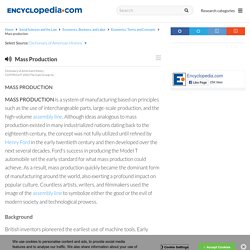
Description, History, Uses, & Limitations. Mass production, with its heavy dependence upon mechanized facilities and high levels of production volume, presents great challenges for industrial leadership.

The importance of advanced planning and the coordinated control of the large human and capital resources associated with mass production have been described. The day-to-day problems of monitoring the status of a major manufacturing complex are also immense. Up-to-the-minute knowledge of status is essential to effective response when difficulties such as the breakdown of a machine, the shortage of required materials or components, or the absence of important employees occur. Many aids to management have been devised for collecting data, analyzing them, and presenting alternatives for management decision.
What is Mass Production? (with pictures) What Are Some Examples of Mass Production? The manufacturing of cars, guns and fast food are examples of mass production.

Mass production is a method of producing goods in large quantities at a low cost per unit. The machine tool industry gave rise to the idea of mass production. Innovators in Britain and the United States began producing interchangeable parts. Although Henry Ford invented an improved version of the assembly line, the first car to be mass produced in the United States was the 1901 Curved Dash Oldsmobile. Henry Ford installed the first conveyor belt assembly line around 1913 or 1914. Concept of Mass Production and its Advantages and Disadvantages. Methods of production - Revision 1 - National 5 Business management - BBC Bitesize. Batch Production. Batch Production. The Myth of Large-Batch Production Manufacturers of everything from cakes to computer chips have many ways of organizing production to increase efficiency.

One of these methods is called batch production, or batch processing. In this approach, instead of manufacturing items individually or continuously, manufacturing moves in groups or batches. Each of the steps in the production process is applied at the same time to an entire batch of items, and that batch does not move onto the next stage of the production process until the whole batch is done. For some situations and products, batch production is the only realistic method. In this case, baking in small batches makes sense, because small quantities of fresh product are needed. An example of a fully continuous process would be the generation of electricity. So the question is: what is the best process for your products, and how can that process be optimized? What is Batch Production? Production: Batch Production Method (GCSE) Production Plan (Microsoft Project File) Workshop Release Inspection Notice. Workshop Capacity Spreadsheet. Production Planning in 5 Steps. Are you a manufacturing firm?
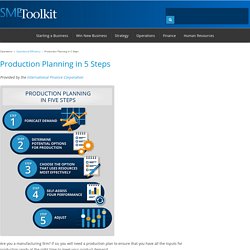
If so, you will need a production plan to ensure that you have all the inputs for production ready at the right time to meet your product demand. Production planning is “the administrative process that takes place within a manufacturing business and that involves making sure that sufficient raw materials, staff and other necessary items are procured and ready to create finished products according to the schedule specified”, as defined by the Business Dictionary. A production plan serves as a guide for your company’s production activities. It establishes and sequences activities which must be carried out to achieve a production target, so that all staff involved are aware of who needs to do what, when, where and how.
A production plan will help you meet product demand while minimizing production time and cost by improving process flow, reducing the waiting time between operations, and optimizing use of plant, equipment and inventory. STEP 1. [Back to top] a. Production plan: Top tips for improving your operations. Effective planning hinges on a sound understanding of key activities that entrepreneurs and business managers should apply to the planning process.
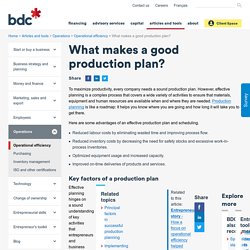
Here are some examples: Forecast market expectations To plan effectively, you will need to estimate potential sales with some reliability. Most businesses don't have firm numbers on future sales. However, you can forecast sales based on historical information, market trends and/or established orders. Inventory control Reliable inventory levels feeding the pipeline have to be established and a sound inventory system should be in place. Availability of equipment and human resources Also known as open time, this is the period of time allowed between processes so that all orders flow within your production line or service. MM Science 201519. Production Planning & Scheduling. The goal of production planning is simply to maintain flow.
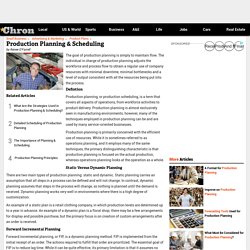
The individual in charge of production planning adjusts the workforce and process flow to obtain a regular use of company resources with minimal downtime, minimal bottlenecks and a level of output consistent with all the resources being put into the process. Defintion Production planning, or production scheduling, is a term that covers all aspects of operations, from workforce activities to product delivery. Production Planning & Scheduling by Excel Spreadsheet for Supply Chain. 6 Basic Principles of Production Planning. Ultimate Product Life Cycle Management Guide. Other Life Cycles Related to Product Life Cycle Management The following are other lifecycles and concepts that you may encounter in the literature, blogs, and possibly in conversation with other professionals.
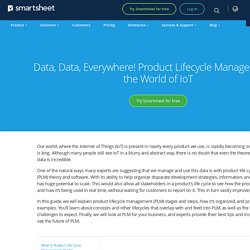
Some are intimately related to PLM, and some are more distant. Product and Process Lifecycle Management Product and Process Life Cycle Management (PPLM) is a part of regular PLM, but for regulated fields such as chemical and pharmaceutical manufacturing. In these industries, the agencies such as the Food and Drug Administration (FDA) tightly regulates the process for manufacturing using either industry specifications or product-specific specifications. Six Sigma For Dummies Cheat Sheet. From Six Sigma For Dummies, 2nd Edition By Craig Gygi, Bruce Williams, Neil DeCarlo, Stephen R.

Covey To apply Six Sigma to your business and produce the best results, you need to understand what Six Sigma is, the principles of Six Sigma, and the DMAIC problem-solving method. The correct tools and use of the Six Sigma scale and methods will keep your data dependable and reusable. What Is Six Sigma? Generally, Six Sigma is a problem-solving methodology that helps enhance business and organizational operations. A quality level of 3.4 defects per million opportunitiesA rate of improvement of 70 percent or betterA data-driven, problem-solving methodology of Define-Measure-Analyze-Improve-ControlAn initiative taken on by organizations to create bottom-line breakthrough change.
BBC Bitesize - GCSE Business - Production.